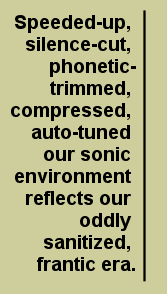
Digital Images and Imaginings
Surely a radio station somewhere in the world is running CASH on material and trimming the recommended four minutes (six and two-thirds percent), and then time compressing that same material by another few percent. If they aren't now, they will be soon, unless otherwise treating the material with an even newer technology that allows for absolute maximum perceivable, corrected content. Speeded-up, silence-cut, phonetic-trimmed, compressed, auto-tuned our sonic environment reflects our oddly sanitized, frantic era. The tools of artistic inflection have never been so available to the engineer and producer who today will typically redraw every single note of a vocalist's performance. This obsessive attention to standardized detail is rampant as material is crammed into every available second of our lives. Competition for attention is paramount, but only within the established, conservative and slow-moving realm of corporate design.
That this is antithetical to the artistic process is not certain: some artists have been able to work within the expected constraints of their epochs and to produce marvelous work. That the process is more frequently taken away from the artist and becomes a collaborative effort is not necessarily problematic. One thinks immediately of film. But the trade-offs in individuation are readily apparent. Predictable is an overt artistic reaction initiated by individuals. To the extent that artists themselves adopt the engineering tools, their visions will remain intact. As more content is thrown at the public, as more and more data is finely spun to specific standards, look to artwork that breathes deeply, that ignores standards. Look to unique vision that demands afforded real time. Be certain that in the vortex that is ever-protean technology this is the lingua franca that truly matters.
Copyright © 22 April 2000 Jeff Talman, New York City, USA
|

 Another method of gaining advertising time in radio is to use a hardware unit that trims silence from material, even live-fed material. The hardware, aptly named CASH,
Another method of gaining advertising time in radio is to use a hardware unit that trims silence from material, even live-fed material. The hardware, aptly named CASH,  As the superfluous detail of unique existence is extinguished, the artist becomes reduced to no more than a raw content provider whose work must be re-configured, trimmed and assimilated into the flow of so much more constant, consistent information.
As the superfluous detail of unique existence is extinguished, the artist becomes reduced to no more than a raw content provider whose work must be re-configured, trimmed and assimilated into the flow of so much more constant, consistent information.